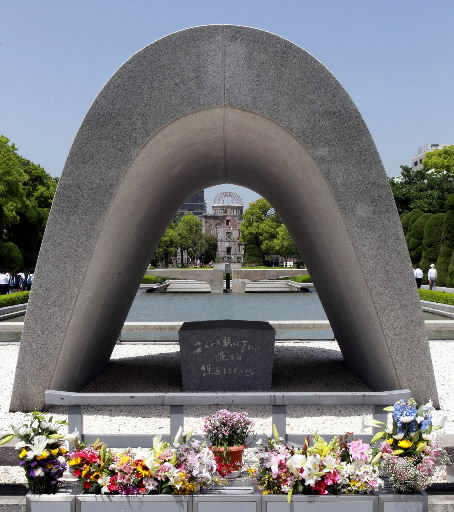- A-bomb Images
- Landmarks of Hiroshima: The Cenotaph for the A-bomb Victims
Landmarks of Hiroshima: The Cenotaph for the A-bomb Victims
by Masami Nishimoto, Editor and Senior Staff Writer
The Cenotaph for the A-bomb Victims in Hiroshima Peace Memorial Park in Naka Ward, Hiroshima, was erected in 1952, after the occupation of Japan by the United States and other allied nations ended earlier that year. On August 6, the cenotaph was unveiled by A-bomb orphans at the Peace Memorial Ceremony.
Initially, the City of Hiroshima asked that the Japanese government approve the creation of a repository for the victims’ ashes at the cenotaph, but the national government declined this request because the cenotaph would be established within the park under construction. The city then asked the national government to approve the cenotaph as the “Memorial Monument for Hiroshima, City of Peace,” which would house the register of the A-bomb victims. The national government gave its approval and granted subsidies for this purpose. In this way, the “Memorial Monument for Hiroshima, City of Peace” became the official name of the cenotaph.
The cenotaph, in the shape of a clay figure of an ancient type of Japanese dwelling, is 4.7 meters wide at the bottom, 3.7 meters tall, and 8.3 meters long at the top. It was designed by Kenzo Tange (1913-2005), who had won the design competition for the park in 1949 and later became a world-renowned architect. Because of the city's tight budget, the cenotaph was originally made of concrete, but the stone chest in the cenotaph where the volumes of the register are kept was created using granite from the island of Kurokami-jima in Yamaguchi Prefecture. The same material is used for the National Diet Building.
On the chest is a three-line inscription that reads: “Let all the souls here rest in peace for we shall not repeat the evil.” The words were conceived by Tadayoshi Saika (1894-1961), a professor at Hiroshima University. Three months after the unveiling of the cenotaph, Radhabinod Pal (1886-1967), an Indian jurist who was attending a World Federalist conference in Asia that was being held in Hiroshima, strongly criticized the inscription, saying, “It was not the Japanese that dropped the atomic bomb.”
Professor Saika, also an A-bomb survivor, explained that the “we” in the inscription meant all of humanity. The controversy, however, simmered on until the end of the 1960s, and involved Hiroshima citizens as well. Finally, in 1983, the city placed a signboard at the cenotaph which explains that the inscription offers a “pledge on behalf of all humanity never to repeat the evil of war.” The roof of the cenotaph was rebuilt in granite in 1985.
The register volumes with the names of A-bomb victims are placed in the chest of the cenotaph at the annual Peace Memorial Ceremony, after the names of victims who died during the past year are added. Approximately 269,000 names have been registered as of last year.
(Originally published on May 16, 2011)
Inscription is a pledge by all of humanity for an end to war
The Cenotaph for the A-bomb Victims in Hiroshima Peace Memorial Park in Naka Ward, Hiroshima, was erected in 1952, after the occupation of Japan by the United States and other allied nations ended earlier that year. On August 6, the cenotaph was unveiled by A-bomb orphans at the Peace Memorial Ceremony.
Initially, the City of Hiroshima asked that the Japanese government approve the creation of a repository for the victims’ ashes at the cenotaph, but the national government declined this request because the cenotaph would be established within the park under construction. The city then asked the national government to approve the cenotaph as the “Memorial Monument for Hiroshima, City of Peace,” which would house the register of the A-bomb victims. The national government gave its approval and granted subsidies for this purpose. In this way, the “Memorial Monument for Hiroshima, City of Peace” became the official name of the cenotaph.
The cenotaph, in the shape of a clay figure of an ancient type of Japanese dwelling, is 4.7 meters wide at the bottom, 3.7 meters tall, and 8.3 meters long at the top. It was designed by Kenzo Tange (1913-2005), who had won the design competition for the park in 1949 and later became a world-renowned architect. Because of the city's tight budget, the cenotaph was originally made of concrete, but the stone chest in the cenotaph where the volumes of the register are kept was created using granite from the island of Kurokami-jima in Yamaguchi Prefecture. The same material is used for the National Diet Building.
On the chest is a three-line inscription that reads: “Let all the souls here rest in peace for we shall not repeat the evil.” The words were conceived by Tadayoshi Saika (1894-1961), a professor at Hiroshima University. Three months after the unveiling of the cenotaph, Radhabinod Pal (1886-1967), an Indian jurist who was attending a World Federalist conference in Asia that was being held in Hiroshima, strongly criticized the inscription, saying, “It was not the Japanese that dropped the atomic bomb.”
Professor Saika, also an A-bomb survivor, explained that the “we” in the inscription meant all of humanity. The controversy, however, simmered on until the end of the 1960s, and involved Hiroshima citizens as well. Finally, in 1983, the city placed a signboard at the cenotaph which explains that the inscription offers a “pledge on behalf of all humanity never to repeat the evil of war.” The roof of the cenotaph was rebuilt in granite in 1985.
The register volumes with the names of A-bomb victims are placed in the chest of the cenotaph at the annual Peace Memorial Ceremony, after the names of victims who died during the past year are added. Approximately 269,000 names have been registered as of last year.
(Originally published on May 16, 2011)







